Abstract
Social vulnerability assessment of natural hazards aims to identify vulnerable populations and provide decision makers with scientific basis for their disaster prevention and mitigation decisions. A new method based on remote sensing is presented here to establish a model of social vulnerability for county-scale regions that lack of relative data. To calculate population density, which is the most important indicator in social vulnerability assessment, first, a statistical model is established to estimate the population on village level. Then a new concept defined as “population density based on land use” is created to replace the arithmetic population density. The former has taken the dynamic human distribution related to land use into account; thus, it can map the population distribution more realistically. The other two indicators are age structure and distance to hospital. The application of this method to the Luogang District of Guangzhou, South China demonstrated its capability of providing high spatial resolution and reasonable social vulnerability for social vulnerability assessment of natural hazards.






Similar content being viewed by others
References
Adger WN (2006) Vulnerability. Global Environ Change Hum Policy Dimens 16(3):268–281
Alonso FG, Roq JLC (1997) Application of NOAA-AVHRR images for the validation and risk assessment of natural disasters in Spain. Remote Sens 96:327–368
Alwang J, Siegel PB, Jørgensen SL (2001) Vulnerability: a view from different disciplines. Social Protection Discussion Paper Series, Social Protection Unit, Human Development Network, The World Bank
Anderson-Berry LJ (2003) Community vulnerability to tropical cyclones: Cairns, 1996–2000. Nat Hazards 30(2):209–232
Armas I (2008) Social vulnerability and seismic risk perception. Case study: the historic center of the Bucharest Municipality/Romania. Nat Hazards 47(3):397–410
Cutter SL, Finch C (2008) Temporal and spatial changes in social vulnerability to natural hazards. Proc Natl Acad Sci USA 105(7):2301–2306
Cutter SL, Mitchell JT, Scott MS (2000) Revealing the vulnerability of people and places: a case study of Georgetown County, South Carolina. Ann Assoc Am Geogr 90(4):713–737
Cutter SL, Boruff BJ, Shirley WL (2003) Social vulnerability to environmental hazards. Soc Sci Q 84(2):242–261
Dai FC, Lee CF, Ngai YY (2002) Landslide risk assessment and management: an overview. Eng Geol 64(1):65–87
Dibben C, Chester DK (1999) Human vulnerability in volcanic environments: the case of Furnas, Sao Miguel, Azores. J Volcanol Geotherm Res 92(1–2):133–150
Dixon RW, Fitzsimons DE (2001) Toward a quantified hurricane vulnerability assessment for Texas coastal counties. Tex J Sci 53(4):345–352
Goodchild MF, Lam NSN (1980) Areal interpolation: a variant of the traditional spatial problem. Geo-Processing 1:297–312
Guzzetti F (2000) Landslide fatalities and the evaluation of landslide risk in Italy. Eng Geol 58(2):89–107
Kienberger S, Lang S, Zeil P (2009) Spatial vulnerability units—expert-based spatial modelling of socio-economic vulnerability in the Salzach catchment, Austria. Nat Hazards Earth Syst Sci 9(3):767–778
King D (2001) Uses and limitations of socioeconomic indicators of community vulnerability to natural hazards: data and disasters in northern Australia. Nat Hazards 24(2):147–156
Lam NSN (1983) Spatial interpolation methods: a review. Am Cartogr 10(2):129–149
Li GY, Weng QH (2005) Using landsat ETM plus imagery to measure population density in Indianapolis, Indiana, USA. Photogram Eng Remote Sens 71(8):947–958
Liu XL, Lei JZ (2003) A method for assessing regional debris flow risk: an application in Zhaotong of Yunnan province (SW China). Geomorphology 52(3–4):181–191
Liverman D, Moran E, Rindfuss R, Stern P (1998) People and pixels: linking remote sensing and social science. National Academy Press, Washington, DC
Mantovani F, Soeters R, VanWesten CJ (1996) Remote sensing techniques for landslide studies and hazard zonation in Europe. Geomorphology 15(3–4):213–225
Marfai MA, King L (2008) Potential vulnerability implications of coastal inundation due to sea level rise for the coastal zone of Semarang city, Indonesia. Environ Geol 54(6):1235–1245
Metternicht G, Hurni L, Gogu R (2005) Remote sensing of landslides: an analysis of the potential contribution to geo-spatial systems for hazard assessment in mountainous environments. Remote Sens Environ 98(2–3):284–303
Pandey A, Dabral PP, Chowdary VM, Yadav NK (2008) Landslide hazard zonation using remote sensing and GIS: a case study of Dikrong river basin, Arunachal Pradesh, India. Environ Geol 54(7):1517–1529
Remondo J, Bonachea J, Cendrero A (2008) Quantitative landslide risk assessment and mapping on the basis of recent occurrences. Geomorphology 94(3–4):496–507
Simpson DM, Human RJ (2008) Large-scale vulnerability assessments for natural hazards. Nat Hazards 47(2):143–155
Sutton P, Roberts D, Elvidge C, Baugh K (2001) Census from Heaven: an estimate of the global human population using night-time satellite imagery. Int J Remote Sens 22(16):3061–3076
Uzielli M, Nadim F, Lacasse S, Kaynia AM (2008) A conceptual framework for quantitative estimation of physical vulnerability to landslides. Eng Geol 102(3–4):251–256
van Westen CJ, van Asch TWJ, Soeters R (2006) Landslide hazard and risk zonation—why is it still so difficult? Bull Eng Geol Environ 65(2):167–184
Wei YM, Fan Y, Lu C, Tsai HT (2004) The assessment of vulnerability to natural disasters in China by using the DEA method. Environ Impact Assess Rev 24(4):427–439
Wu SS, Qiu XM, Wang L (2005) Population estimation methods in GIS and remote sensing: a review. GISci Remote Sens 42(1):80–96
Yao H, Xu X, Xue D (2008) On characteristics and spatial difference of floating populations in Guangzhou. Trop Geogr 28(3):259–264
Zhang GR, Yin KL, Chen LX (2007) Population vulnerability assessment on regional landslide hazards and casualty risk forecasting in Yongjia County, Zhejiang Province. Geol Sci Technol Inf 26(4):70–75
Acknowledgments
This is contribution No. IS-1334 from GIGCAS. This study is financially supported by the project of Finance department in Guangzhou (grant No. GZCY2008FG10008C-2), the science and technology project of Guangzhou (grant No. 2008J1-C051), and the key project of Guangdong province (grant No. 2008A030203003). Thanks are also given to Wu Zhifeng, Zhou Xinjing, Zeng Wei, Gong Jingping, Lv Huiping, Liu Weiping and Lu Wei for their help.
Author information
Authors and Affiliations
Corresponding author
Rights and permissions
About this article
Cite this article
Zeng, J., Zhu, Z.Y., Zhang, J.L. et al. Social vulnerability assessment of natural hazards on county-scale using high spatial resolution satellite imagery: a case study in the Luogang district of Guangzhou, South China. Environ Earth Sci 65, 173–182 (2012). https://doi.org/10.1007/s12665-011-1079-8
Received:
Accepted:
Published:
Issue Date:
DOI: https://doi.org/10.1007/s12665-011-1079-8




